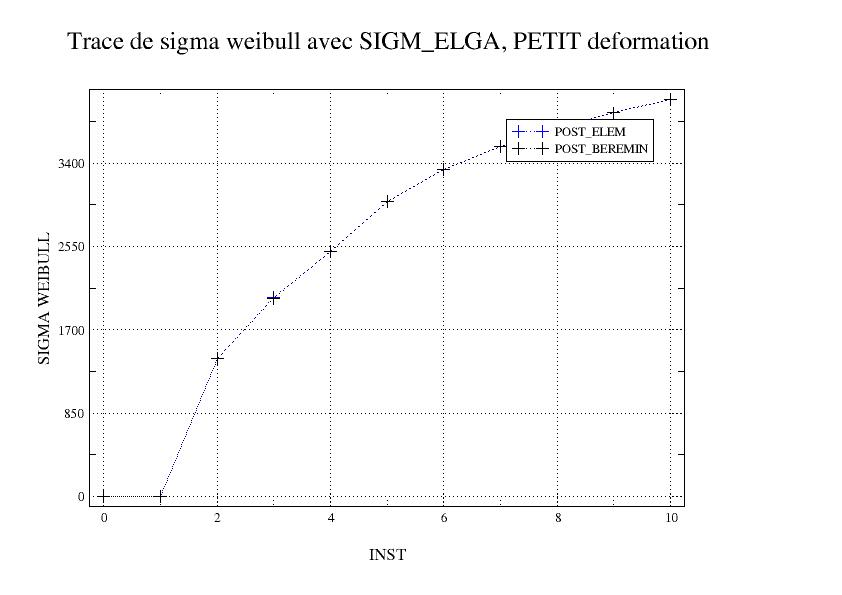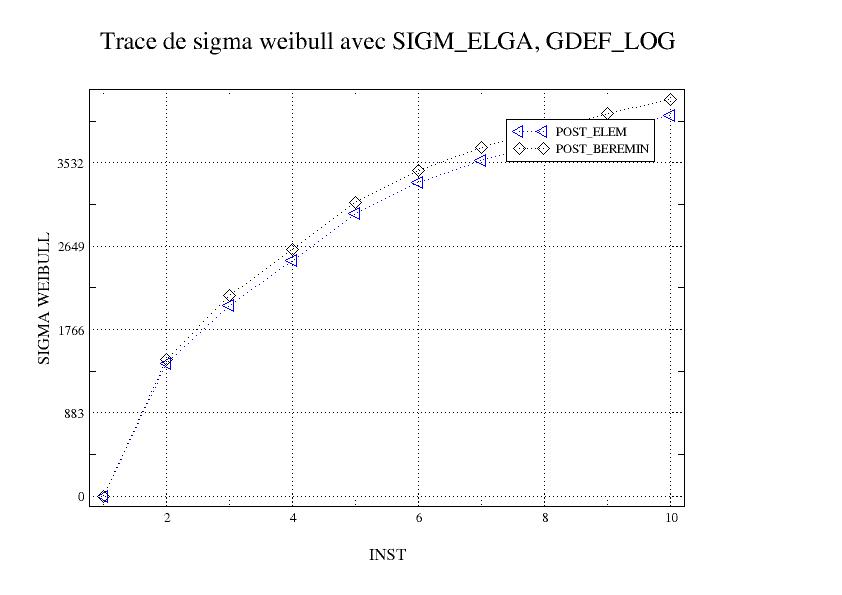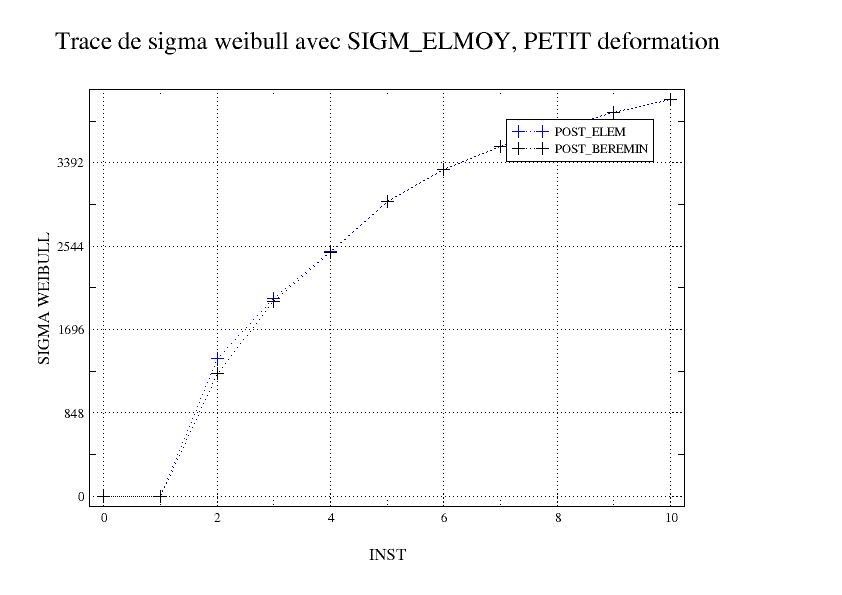4. Model A results#
4.1. Tested values#
The parameters of the result data structure are tested:
Identification |
Reference |
Test |
Tolerance |
INSTpour NUME_ORDRE =10 |
10.0 |
|
0.10% |
ITER_GLOB |
8 |
|
|
Weibull model:
Identification |
Reference |
T type |
Tolerance |
Weibull constraint for \(\mathit{INST}=\mathrm{2,0}\) |
1.4075E+003 |
|
0.1% (relative) |
Weibull constraint for \(\mathit{INST}=\mathrm{4,0}\) |
2.4966E+003 |
|
0.1% (relative) |
Weibull constraint for \(\mathit{INST}=\mathrm{6,0}\) |
3.3332E+003 |
|
0.1% (relative) |
Weibull constraint for \(\mathit{INST}=\mathrm{8,0}\) |
3.7535E+003 |
|
0.1% (relative) |
Weibull constraint for \(\mathit{INST}=\mathrm{10,0}\) |
4.0474E+003 |
|
0.1% (relative) |
The Weibull stress obtained with the 2 commands (POST_ELEM and POST_BEREMIN) with option SIGM_ELGA for small deformations are compared to the figure below:

The Weibull stress obtained with the 2 commands (POST_ELEM and POST_BEREMIN) with option SIGM_ELGA for the large deformations are compared to the figure below:
Note: in large logarithmic deformations (GDEF_LOG), the macro command POST_BEREMIN uses the specific constraint field \(T\), while the macro command POST_ELEM uses the Cauchy stress field \(\mathrm{\sigma }\) (see [R5.03.24]).

The Weibull stress obtained with the 2 commands (POST_ELEM and POST_BEREMIN) with option SIGM_ELMOY for small deformations are compared to the figure below:

Rice-Tracey model:
Identification |
Reference |
Type |
Tolerance |
Cavity growth rate for \(\mathit{INST}\mathrm{=}\mathrm{1,0}\) |
1.0000E+000 |
|
0.1% (relative) |
Cavity volume for \(\mathit{INST}\mathrm{=}\mathrm{1,0}\) |
3.7500E+000 |
|
0.1% (relative) |
Cavity growth rate for \(\mathit{INST}\mathrm{=}\mathrm{3,0}\) |
1.0014E+000 |
|
0.1% (relative) |
Cavity volume for \(\mathit{INST}\mathrm{=}\mathrm{3,0}\) |
6.2372E-001 |
|
0.1% (relative) |
Cavity growth rate for \(\mathit{INST}\mathrm{=}\mathrm{5,0}\) |
1.0076E+000 |
|
0.1% (relative) |
Cavity growth rate for \(\mathit{INST}\mathrm{=}\mathrm{7,0}\) |
1.0170E+000 |
|
0.1% (relative) |
Cavity growth rate for \(\mathit{INST}\mathrm{=}\mathrm{10,0}\) |
1.0315E+000 |
|
0.1% (relative) |
Bordet model:
Identification |
Reference |
Test |
Tolerance |
Bordet constraint for \(\mathit{INST}\mathrm{=}\mathrm{2,0}\) |
0.0000E+000 |
|
0.1% (relative) |
Bordet stress for \(\mathit{INST}\mathrm{=}\mathrm{4,0}\) |
7.2180E+002 |
|
0.1% (relative) |
Bordet constraint for \(\mathit{INST}\mathrm{=}\mathrm{6,0}\) |
1.3024E+003 |
|
0.1% (relative) |
Bordet constraint for \(\mathit{INST}\mathrm{=}\mathrm{8,0}\) |
1.7305E+003 |
|
0.1% (relative) |
Bordet constraint for \(\mathit{INST}\mathrm{=}\mathrm{10,0}\) |
2.0225E+003 |
|
0.1% (relative) |